A Case Study on the Vertical Distribution and Correlation Between Low-Frequency Lightning Sources and Hydrometeors During a Thunderstorm
Abstract
1. Introduction
2. Materials and Methods
2.1. Lightning Data from the 3D Mapping by LFILMA
2.2. Weather Radar Data from the NEXRAD System
2.3. Data Reprocessing and Combination of Lightning and Radar Data
3. Results
3.1. Overview of the Development Stages During the Storm
3.2. Correlation Between Hydrometeors and Lightning Sources Within Different Convective Cores
3.2.1. Convective Core A
3.2.2. Convective Core B
3.2.3. Convective Core C
4. Discussion
5. Conclusions
Author Contributions
Funding
Data Availability Statement
Conflicts of Interest
References
- Takahashi, T. Riming electrification as a charge generation mechanism in thunderstorms. J. Atmos. Sci. 1978, 35, 1536–1548. [Google Scholar] [CrossRef]
- Saunders, C.P.R.; Keith, W.D.; Mitzeva, R.P. The effect of liquid water on thunderstorm charging. J. Geophys. Res. Atmos. 1991, 96, 11007–11017. [Google Scholar] [CrossRef]
- MacGorman, D.R.; Burgess, D.W.; Mazur, V.; Rust, D.W.; Taylor, L.W.; Johnson, B.C. Lightning rates relative to tornadic storm evolution on 22 May 1981. J. Atmos. Sci. 1989, 46, 221–250. [Google Scholar] [CrossRef]
- Ribaud, J.-F.; Bousquet, O.; Coquillat, S. Relationships between total lightning activity, microphysics, and kinematics during the 24 September 2012 HyMeX bow-echo system. Q. J. R. Meteorol. Soc. 2016, 142, 298–309. [Google Scholar] [CrossRef]
- Zhang, T.; Zhao, G.; Wei, C.; Gao, Y.; Yu, H.; Zhou, F. Relationships between cloud-to-ground flashes and hydrometeors in a thunderstorm in Fujian province. J. Atmos. Sol. Terr. Phys. 2017, 154, 226–235. [Google Scholar] [CrossRef]
- Nisi, L.; Hering, A.; Germann, U.; Schroeer, K.; Barras, H.; Kunz, M.; Martius, O. Hailstorms in the Alpine region: Diurnal cycle, 4D-characteristics, and the nowcasting potential of lightning properties. Q. J. R. Meteorol. Soc. 2020, 146, 4170–4194. [Google Scholar] [CrossRef]
- Li, Z.; Zhang, T.; Bao, M.; Yu, H.; Su, T.; Lin, H. Relationships between cloud-to-ground flashes and ice-phase hydrometeors in a tropical hailstorm. J. Atmos. Sol. Terr. Phys. 2022, 241, 105978. [Google Scholar] [CrossRef]
- Michibata, T. Significant increase in graupel and lightning occurrence in a warmer climate simulated by prognostic graupel parameterization. Sci. Rep. 2024, 14, 3862. [Google Scholar] [CrossRef]
- Carey, L.D.; Murphy, M.J.; McCormick, T.L.; Demetriades, N.W.S. Lightning location relative to storm structure in a leading-line, trailing-stratiform mesoscale convective system. J. Geophys. Res. Atmos. 2005, 110, D03105. [Google Scholar] [CrossRef]
- Wiens, K.C.; Rutledge, S.A.; Tessendorf, S.A. The 29 June 2000 supercell observed during STEPS. Part II: Lightning and charge structure. J. Atmos. Sci. 2005, 62, 4151–4177. [Google Scholar] [CrossRef]
- Lund, N.R.; MacGorman, D.R.; Schuur, T.J.; Biggerstaff, M.I.; Rust, W.D. Relationships between lightning location and polarimetric radar signatures in a small mesoscale convective system. Mon. Weather Rev. 2009, 137, 4151–4170. [Google Scholar] [CrossRef]
- Hayashi, S.; Umehara, A.; Nagumo, N.; Ushio, T. The relationship between lightning flash rate and ice-related volume derived from dual-polarization radar. Atmos. Res. 2021, 248, 105166. [Google Scholar] [CrossRef]
- Saunders, C.P.R.; Bax-Norman, H.; Emersic, C.; Avila, E.E.; Castellano, N.E. Laboratory studies of the effect of cloud conditions on graupel/crystal charge transfer in thunderstorm electrification. Q. J. R. Meteorol. Soc. 2006, 132, 2653–2673. [Google Scholar] [CrossRef]
- Kouketsu, T.; Uyeda, H.; Ohigashi, T.; Tsuboki, K. Relationship between cloud-to-ground lightning polarity and the space-time distribution of solid hydrometeors in isolated summer thunderclouds observed by X-band polarimetric radar. J. Geophys. Res. Atmos. 2017, 122, 8781–8800. [Google Scholar] [CrossRef]
- Schultz, C.J.; Carey, L.D.; Schultz, E.V.; Blakeslee, R.J. Kinematic and microphysical significance of lightning jumps versus nonjump increases in total flash rate. Weather Forecast. 2017, 32, 275–288. [Google Scholar] [CrossRef] [PubMed]
- Liu, Y.; Lyu, F.; Wang, M.; Xu, W.; Xi, D.; Jiang, S. Lightning characteristics and associated microphysical parameters in a strong thunderstorm with an extreme gale. Nat. Hazards 2024, 120, 12451–12469. [Google Scholar] [CrossRef]
- Rison, W.; Thomas, R.J.; Krehbiel, P.R.; Hamlin, T.; Harlin, J. A GPS-based three-dimensional lightning mapping system: Initial observations in central New Mexico. Geophys. Res. Lett. 1999, 26, 3573–3576. [Google Scholar] [CrossRef]
- Thomas, R.J.; Krehbiel, P.R.; Rison, W.; Hunyady, S.J.; Winn, W.P.; Hamlin, T.; Harlin, J. Accuracy of the Lightning Mapping Array. J. Geophys. Res. Atmos. 2004, 109, D14207. [Google Scholar] [CrossRef]
- Yoshida, S.; Wu, T.; Ushio, T.; Kusunoki, K.; Nakamura, Y. Initial results of LF sensor network for lightning observation and characteristics of lightning emission in LF band. J. Geophys. Res. Atmos. 2014, 119, 12034–12051. [Google Scholar] [CrossRef]
- Wang, Y.; Qie, X.; Wang, D.; Liu, M.; Su, D.; Wang, Z.; Liu, D.; Wu, Z.; Sun, Z.; Tian, Y. Beijing Lightning Network (BLNET) and the observation on preliminary breakdown processes. Atmos. Res. 2016, 171, 121–132. [Google Scholar] [CrossRef]
- Lyu, F.; Cummer, S.A.; Chen, M.; Qin, Z.; Lyu, W.; Sun, J. Three-dimensional mapping of two coincident flashes—An upward positive flash triggered by the in-cloud activity of a downward negative flash. Atmos. Res. 2021, 250, 105408. [Google Scholar] [CrossRef]
- Bruning, E.C.; Rust, W.D.; Schuur, T.J.; MacGorman, D.R.; Krehbiel, P.R.; Rison, W. Electrical and polarimetric radar observations of a multicell storm in TELEX. Mon. Weather Rev. 2007, 135, 2525–2544. [Google Scholar] [CrossRef]
- Liu, D.X.; Qie, X.S.; Chen, Y.C.; Sun, Z.L.; Yuan, S.F. Investigating lightning characteristics through a supercell storm by comprehensive coordinated observations over North China. Adv. Atmos. Sci. 2020, 37, 861–872. [Google Scholar] [CrossRef]
- Yang, J.; Zhao, K.; Zheng, Y.; Chen, H.; Chen, G. Microphysical structure of thunderstorms and their lightning activity during the mei-yu and post-mei-yu periods over Nanjing, Yangtze River Delta. Geophys. Res. Lett. 2022, 49, e2022GL100952. [Google Scholar] [CrossRef]
- Lyu, F.; Cummer, S.A.; Solanki, R.; Weinert, J.; McTague, L.; Katko, A.; Barrett, J.; Zigoneanu, L.; Xie, Y.B.; Wang, W.Q. A low-frequency near-field interferometric-TOA 3-D Lightning Mapping Array. Geophys. Res. Lett. 2014, 41, 7777–7784. [Google Scholar] [CrossRef]
- Stock, M.G.; Akita, M.; Krehbiel, P.R.; Rison, W.; Edens, H.E.; Kawasaki, Z.; Stanley, M.A. Continuous broadband digital interferometry of lightning using a generalized cross-correlation algorithm. J. Geophys. Res. Atmos. 2014, 119, 3134–3165. [Google Scholar] [CrossRef]
- Lyu, F.; Cummer, S.A.; Lu, G.P.; Zhou, X.; Weinert, J. Imaging lightning intracloud initial stepped leaders by low-frequency interferometric lightning mapping array. Geophys. Res. Lett. 2016, 43, 5516–5523. [Google Scholar] [CrossRef]
- Doviak, R.J.; Bringi, V.; Ryzhkov, A.; Zahrai, A.; Zrnić, D. Considerations for polarimetric upgrades to operational WSR-88D radars. J. Atmos. Ocean. Technol. 2000, 17, 257–278. [Google Scholar] [CrossRef]
- Ryzhkov, A.V.; Giangrande, S.E.; Schuur, T.J. Rainfall estimation with a polarimetric prototype of WSR-88D. J. Appl. Meteorol. 2005, 44, 502–515. [Google Scholar] [CrossRef]
- Qin, Z.; Chen, M.; Lyu, F.; Cummer, S.A.; Zhu, B.; Liu, F.; Du, Y. A GPU-based grid traverse algorithm for accelerating lightning geolocation process. IEEE Trans. Electromagn. Compat. 2020, 62, 489–497. [Google Scholar] [CrossRef]
- Wu, T.; Wang, D.H.; Takagi, N. Lightning mapping with an array of fast antennas. Geophys. Res. Lett. 2018, 45, 3698–3705. [Google Scholar] [CrossRef]
- Zhu, Y.; Bitzer, P.; Stewart, M.; Podgorny, S.; Corredor, D.; Burchfield, J.; Carey, L.; Medina, B.; Stock, M. Huntsville Alabama Marx Meter Array 2: Upgrade and capability. Earth Space Sci. 2020, 7, e2020EA001111. [Google Scholar] [CrossRef]
- Wang, F.; Zhang, Y.J.; Liu, H.Y.; Yao, W.; Meng, Q. Characteristics of cloud-to-ground lightning strikes in the stratiform regions of mesoscale convective systems. Atmos. Res. 2016, 178–179, 207–216. [Google Scholar] [CrossRef]
- Liu, D.X.; Sun, M.Y.; Su, D.B.; Xu, W.J.; Yu, H.; Chen, Y.C. A five-year climatological lightning characteristics of linear mesoscale convective systems over North China. Atmos. Res. 2021, 256, 105580. [Google Scholar] [CrossRef]
- Ren, Y.S.; Xu, W.X.; Fu, J.L. Characteristics of intracloud lightning to cloud-to-ground lightning ratio in thunderstorms over Eastern and Southern China. Atmos. Res. 2024, 300, 107231. [Google Scholar] [CrossRef]
- Ni, X.; Liu, C.T.; Zipser, E. Ice microphysical properties near the tops of deep convective cores implied by the GPM dual-frequency radar observations. J. Atmos. Sci. 2019, 76, 2899–2917. [Google Scholar] [CrossRef]
- Brooks, I.M.; Saunders, C.P.R.; Mitzeva, R.P.; Peck, S.L. The effect on thunderstorm charging of the rate of rime accretion by graupel. Atmos. Res. 1997, 43, 277–295. [Google Scholar] [CrossRef]
- Barthe, C.; Hoarau, T.; Bovalo, C. Cloud electrification and lightning activity in a tropical cyclone-like vortex. Atmos. Res. 2016, 180, 297–309. [Google Scholar] [CrossRef]
- Zhao, C.; Zhang, Y.; Zheng, D.; Li, H.; Du, S.; Peng, X.; Liu, X.; Zhao, P.; Zheng, J.; Shi, J. On the ice microphysics of isolated thunderstorms and non-thunderstorms in southern China—A radar polarimetric perspective. Atmos. Chem. Phys. 2024, 24, 11637–11651. [Google Scholar] [CrossRef]
- Ziegler, C.L.; MacGorman, D.R.; Dye, J.E.; Ray, P.S. A model evaluation of noninductive graupel-ice charging in the early electrification of a mountain thunderstorm. J. Geophys. Res. 1991, 96, 12833. [Google Scholar] [CrossRef]
- López, R.E.; Aubagnac, J.-P. The lightning activity of a hailstorm as a function of changes in its microphysical characteristics inferred from polarimetric radar observations. J. Geophys. Res. Atmos. 1997, 102, 16799–16813. [Google Scholar] [CrossRef]
- Mattos, E.V.; Machado, L.A.T.; Williams, E.R.; Goodman, S.J.; Blakeslee, R.J.; Bailey, J.C. Electrification life cycle of incipient thunderstorms. J. Geophys. Res. Atmos. 2017, 122, 4670–4697. [Google Scholar] [CrossRef]
- Lang, T.J.; Rutledge, S.A. Kinematic, microphysical, and electrical aspects of an asymmetric bow-echo mesoscale convective system observed during STEPS 2000. J. Geophys. Res. 2008, 113, D08213. [Google Scholar] [CrossRef]
- Wang, F.; Zhang, Y.; Dong, W.; Liu, H.; Feng, L.; Yao, W. Characteristics of negative leader propagation area of lightning flashes initiated in the stratiform regions of mesoscale convective systems. J. Geophys. Res. Atmos. 2021, 126, e2020JD033336. [Google Scholar] [CrossRef]
- Wang, S.; Wada, Y.; Hayashi, S.; Ushio, T.; Chandrasekar, V. Observation of electrical alignment signatures in an isolated thunderstorm by dual-polarized phased array weather radar and the relationship with intracloud lightning flash rate. J. Geophys. Res. Atmos. 2024, 129, e2023JD040681. [Google Scholar] [CrossRef]
- Heymsfield, A.J. Case study of a hailstorm in Colorado. Part IV: Graupel and hail growth mechanisms deduced through particle trajectory calculations. J. Atmos. Sci. 1983, 40, 1482–1509. [Google Scholar] [CrossRef]
- Miller, L.J.; Tuttle, J.D.; Foote, G.B. Precipitation production in a large Montana hailstorm: Airflow and particle growth trajectories. J. Atmos. Sci. 1990, 47, 1619–1646. [Google Scholar] [CrossRef][Green Version]
- Deierling, W.; Petersen, W.A. Total lightning activity as an indicator of updraft characteristics. J. Geophys. Res. 2008, 113, D16210. [Google Scholar] [CrossRef]
- Stolzenburg, M.; Rust, W.D.; Smull, B.F.; Marshall, T.C. Electrical structure in thunderstorm convective regions: 1. Mesoscale convective systems. J. Geophys. Res. Atmos. 1998, 103, 14059–14078. [Google Scholar] [CrossRef]
- Stough, S.M.; Carey, L.D. Observations of anomalous charge structures in supercell thunderstorms in the Southeastern United States. J. Geophys. Res. Atmos. 2020, 125, e2020JD033012. [Google Scholar] [CrossRef]
- Carey, L.D.; Rutledge, S.A. A multiparameter radar case study of the microphysical and kinematic evolution of a lightning producing storm. Meteorol. Atmos. Phys. 1996, 59, 33–64. [Google Scholar] [CrossRef]
- Carey, L.D.; Rutledge, S.A. The relationship between precipitation and lightning in tropical island convection: A C-band polarimetric radar study. Mon. Weather Rev. 2000, 128, 2687–2710. [Google Scholar] [CrossRef]
- Fehr, T.; Dotzek, N.; Höller, H. Comparison of lightning activity and radar-retrieved microphysical properties in EULINOX storms. Atmos. Res. 2005, 76, 167–189. [Google Scholar] [CrossRef]
- Basarab, B.M.; Rutledge, S.A.; Fuchs, B.R. An improved lightning flash rate parameterization developed from Colorado DC3 thunderstorm data for use in cloud-resolving chemical transport models. J. Geophys. Res. Atmos. 2015, 120, 9481–9499. [Google Scholar] [CrossRef]
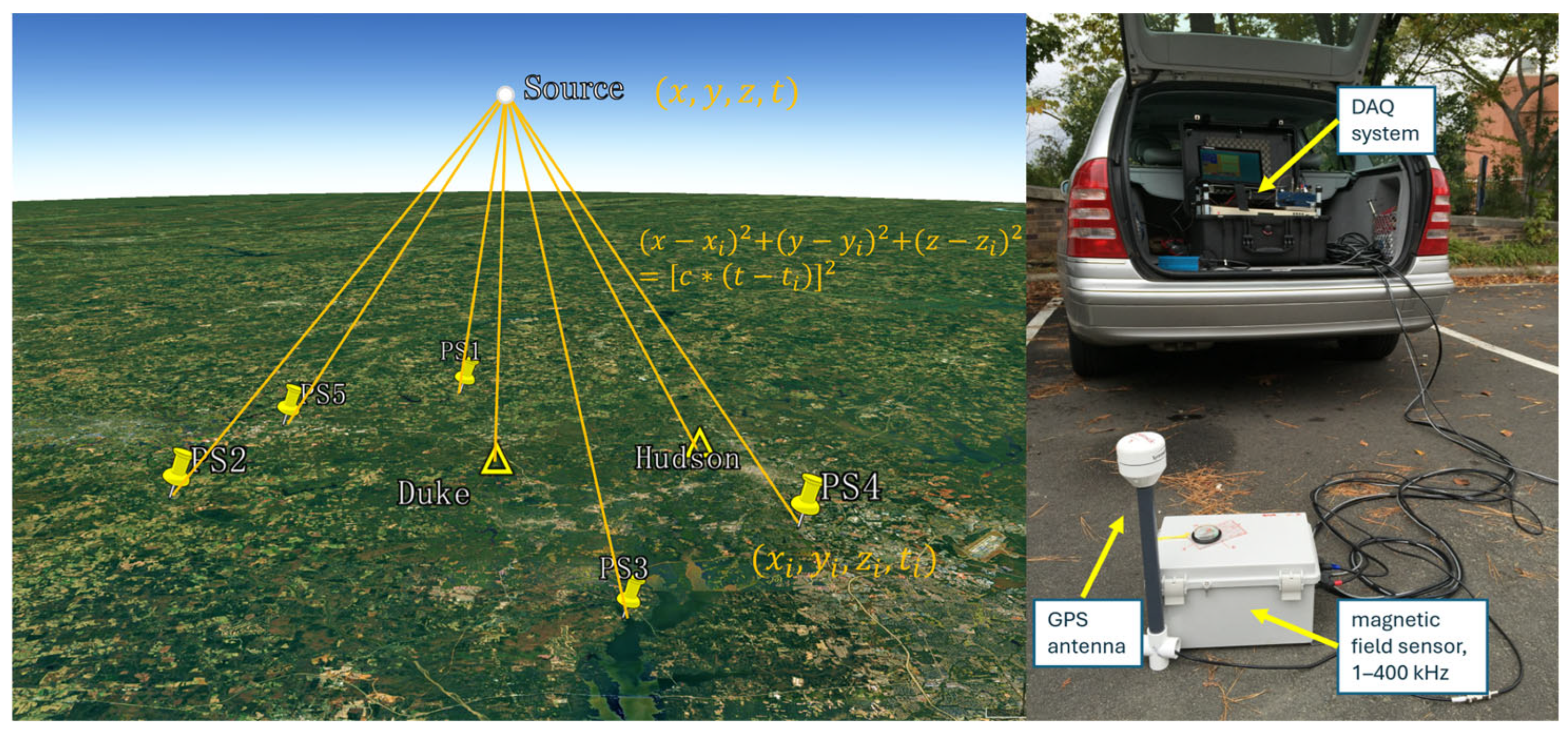
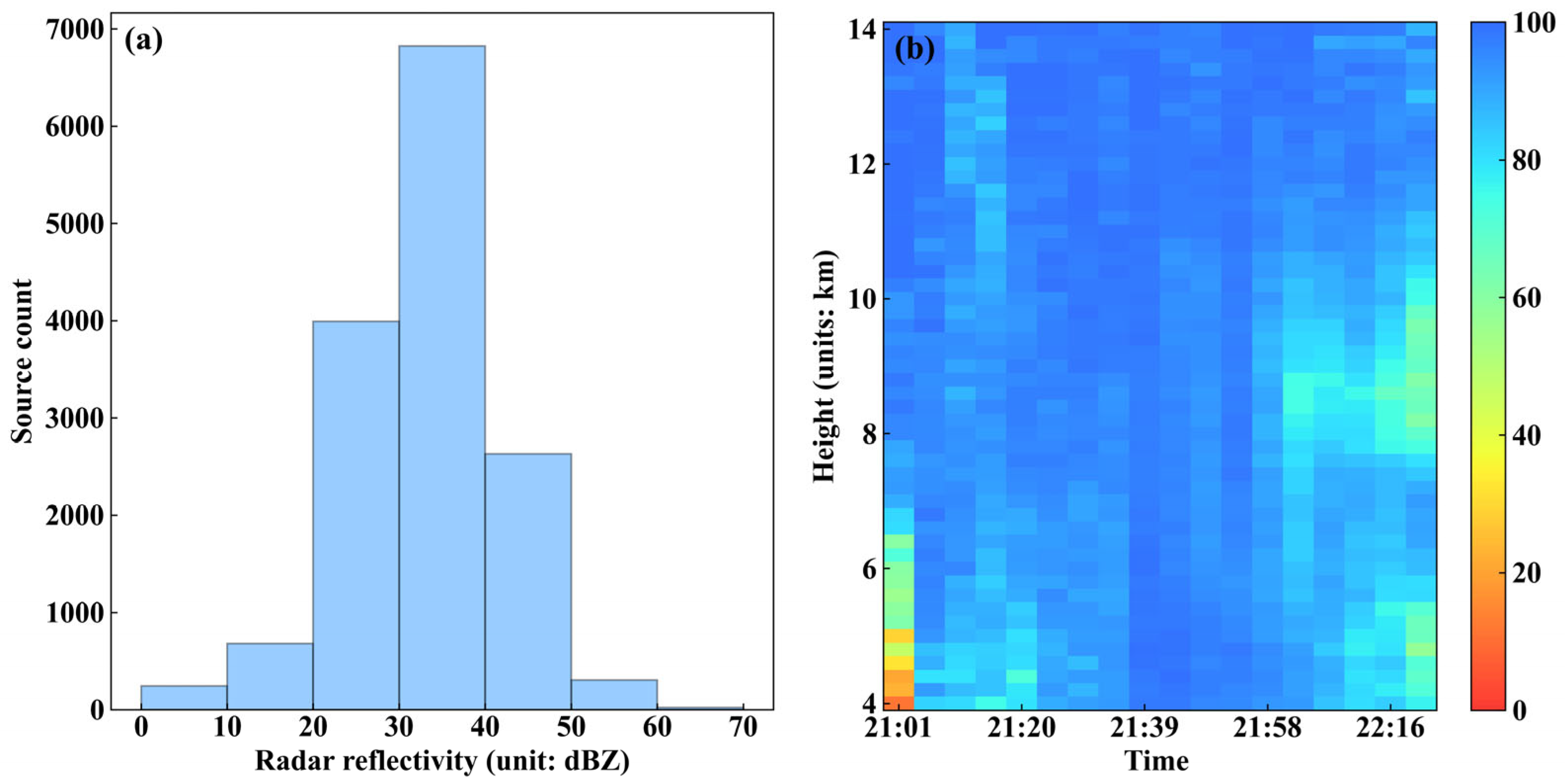
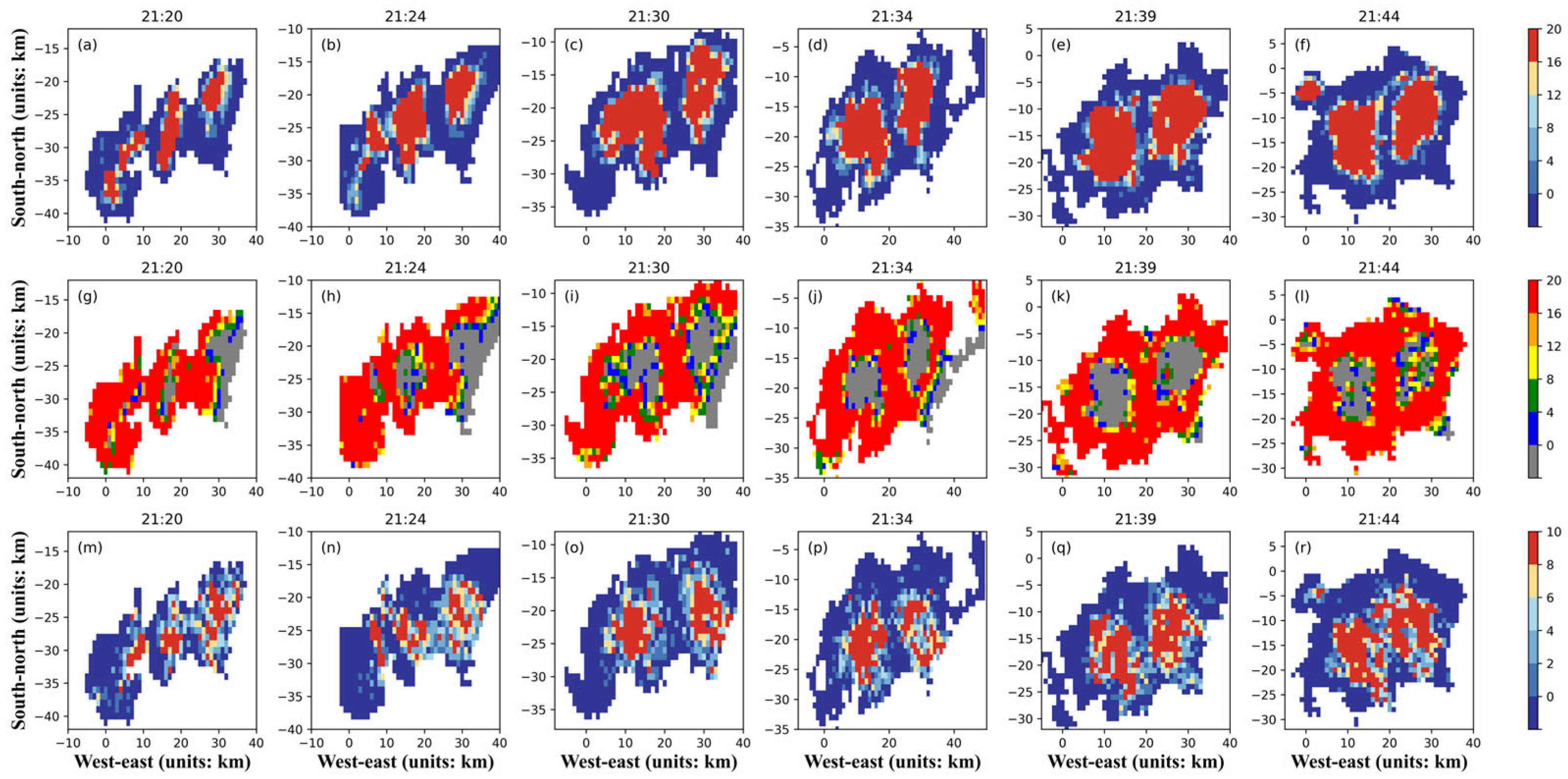
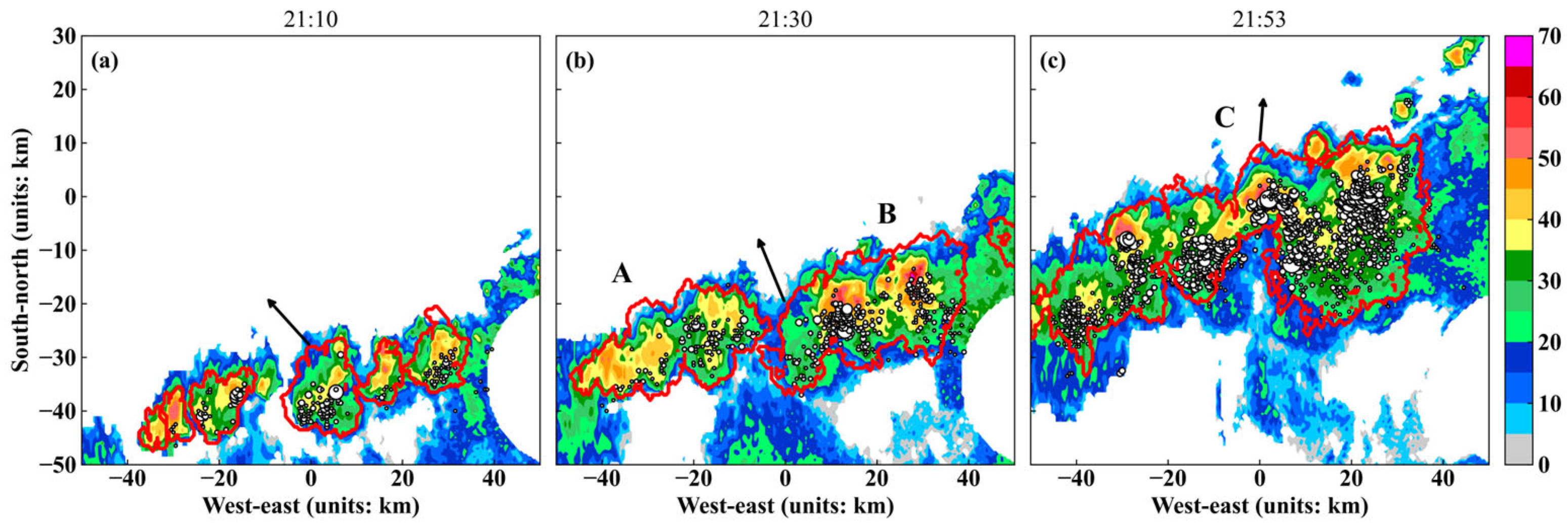
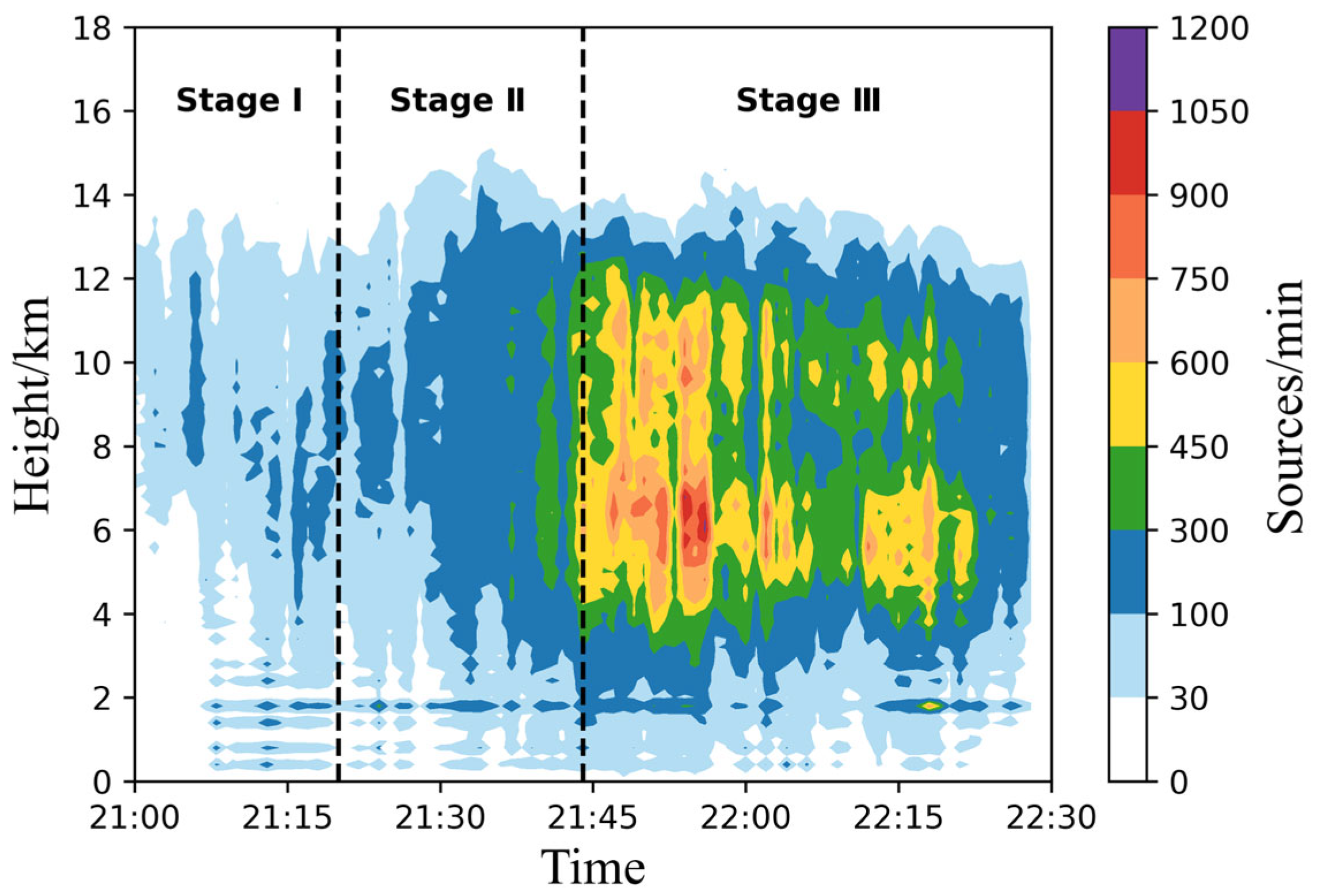
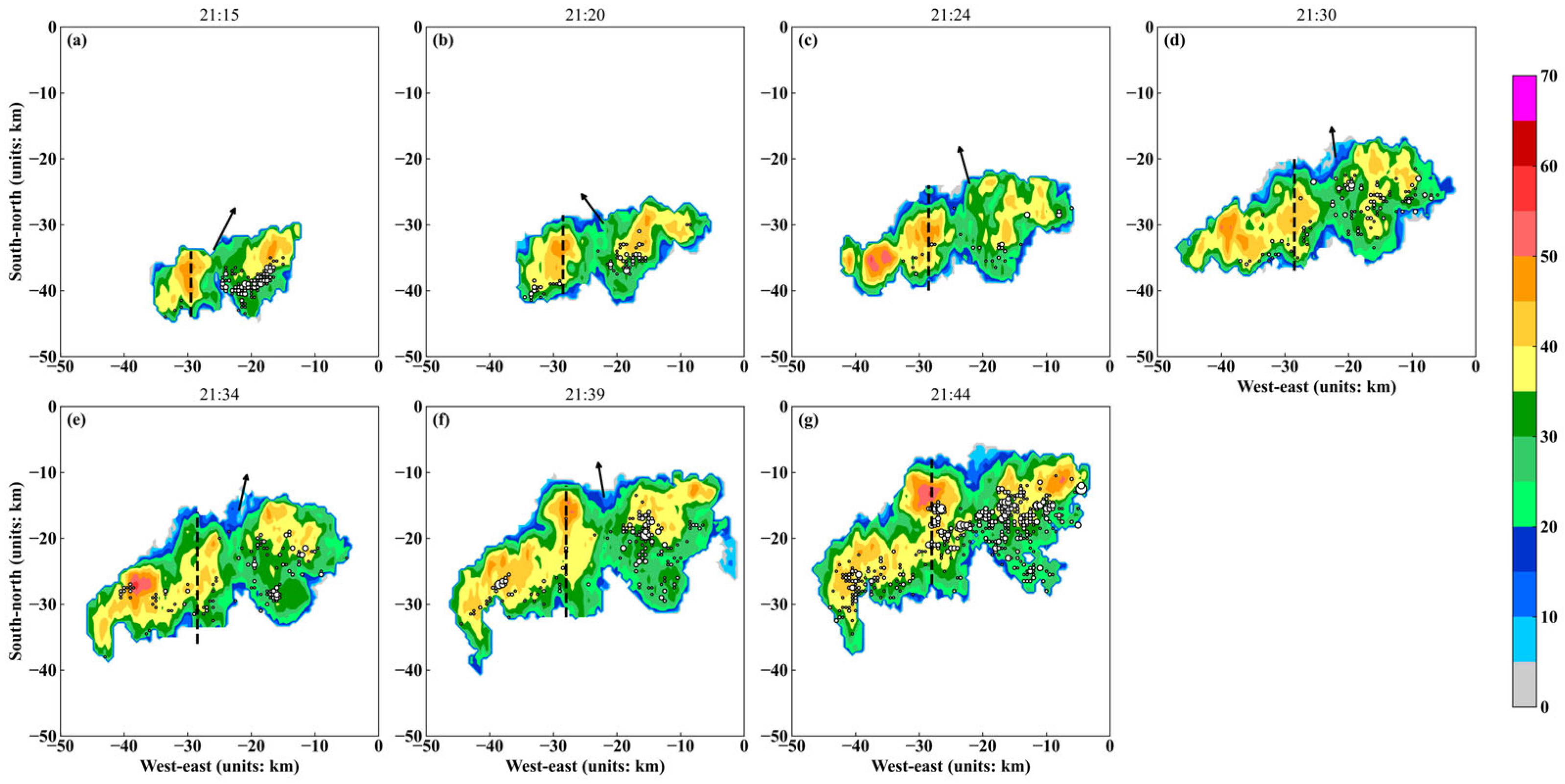

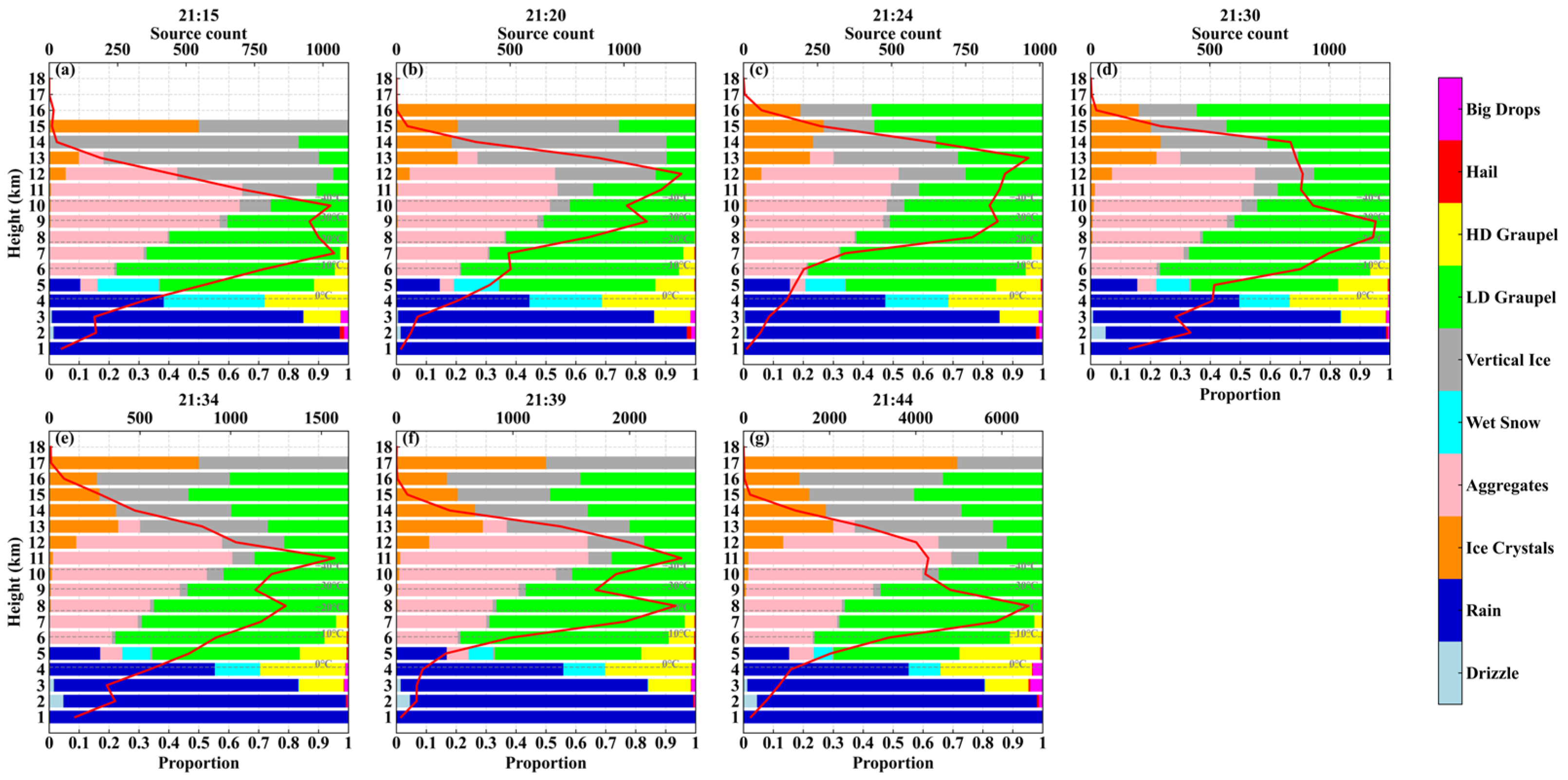
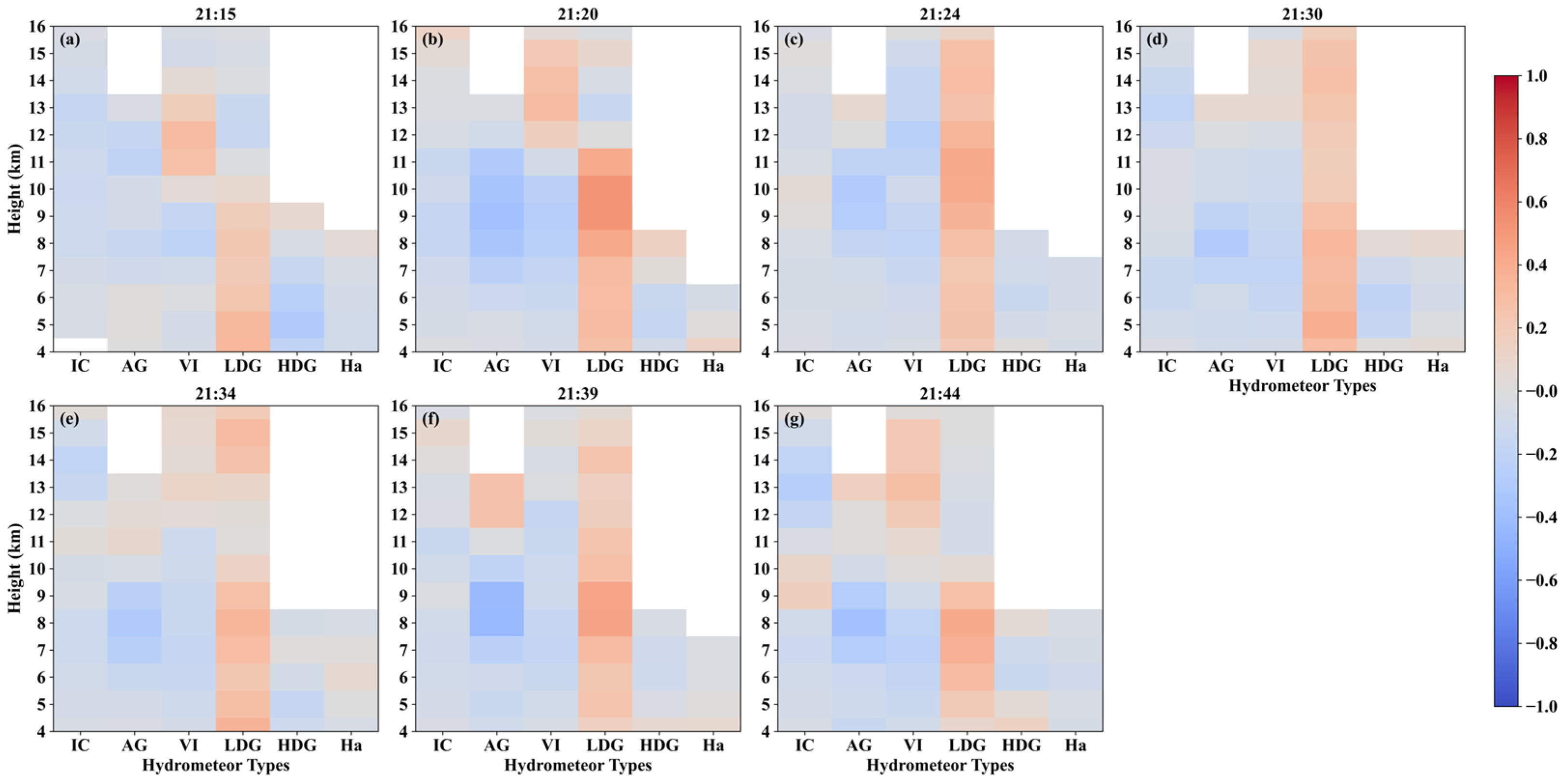
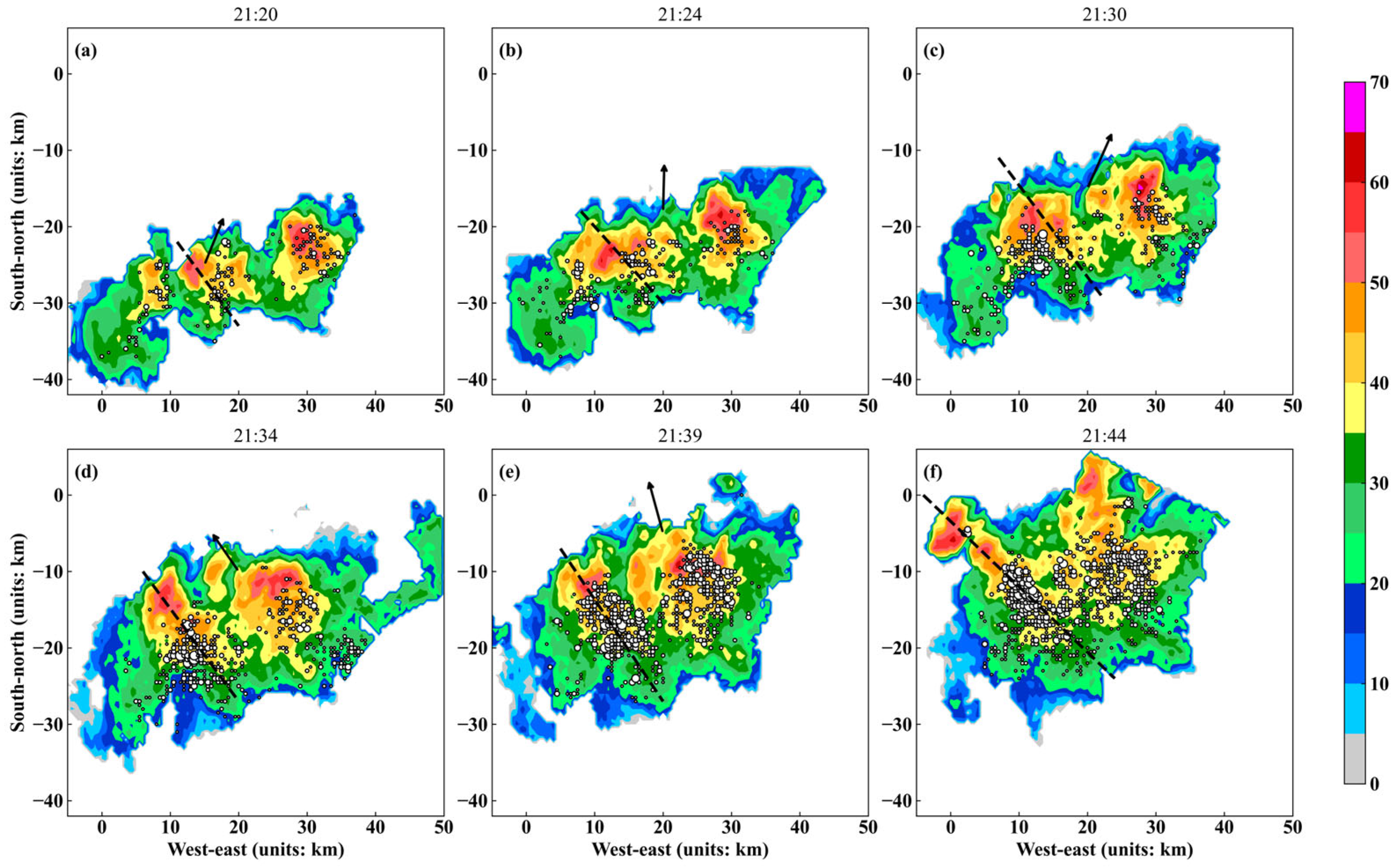
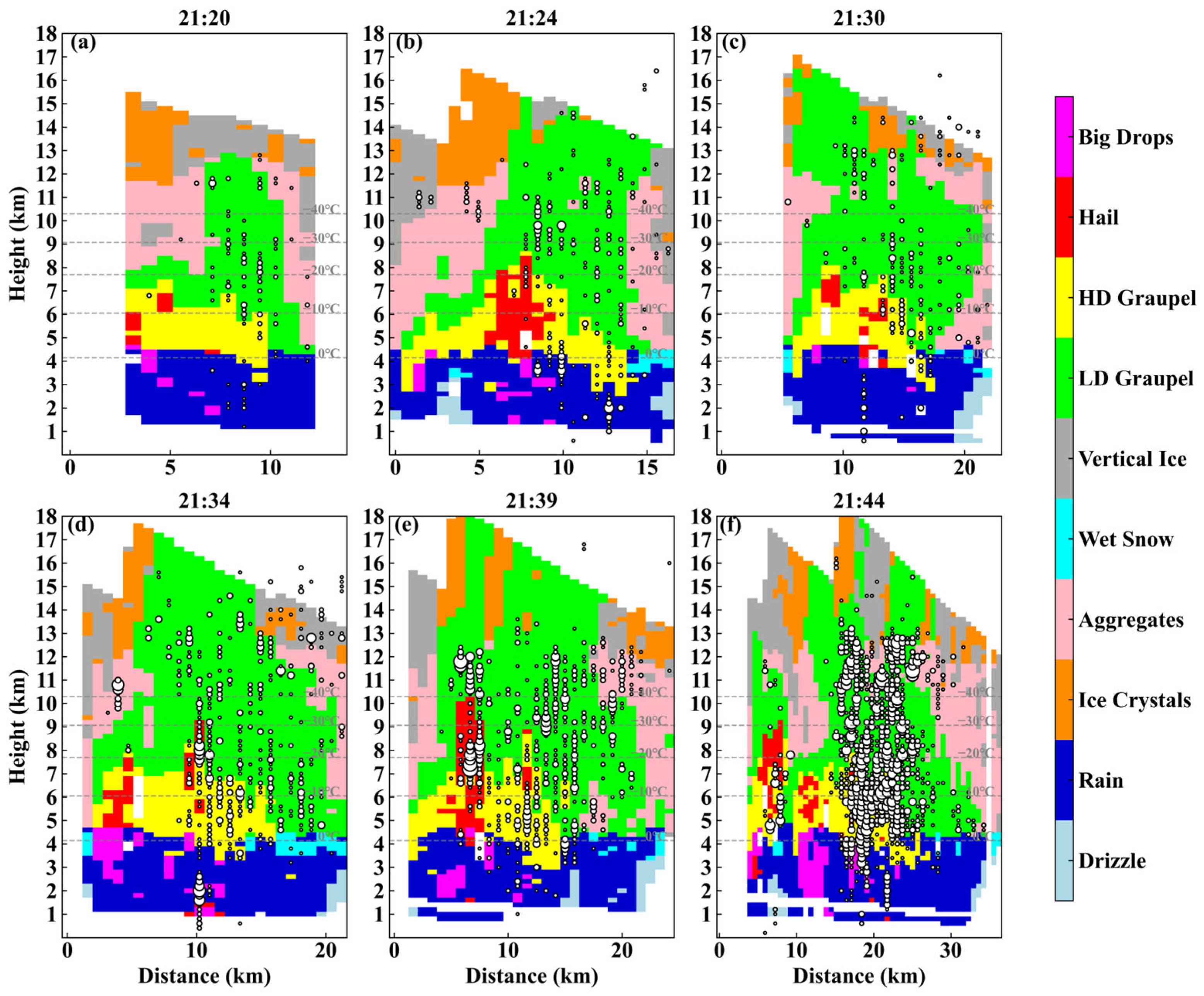
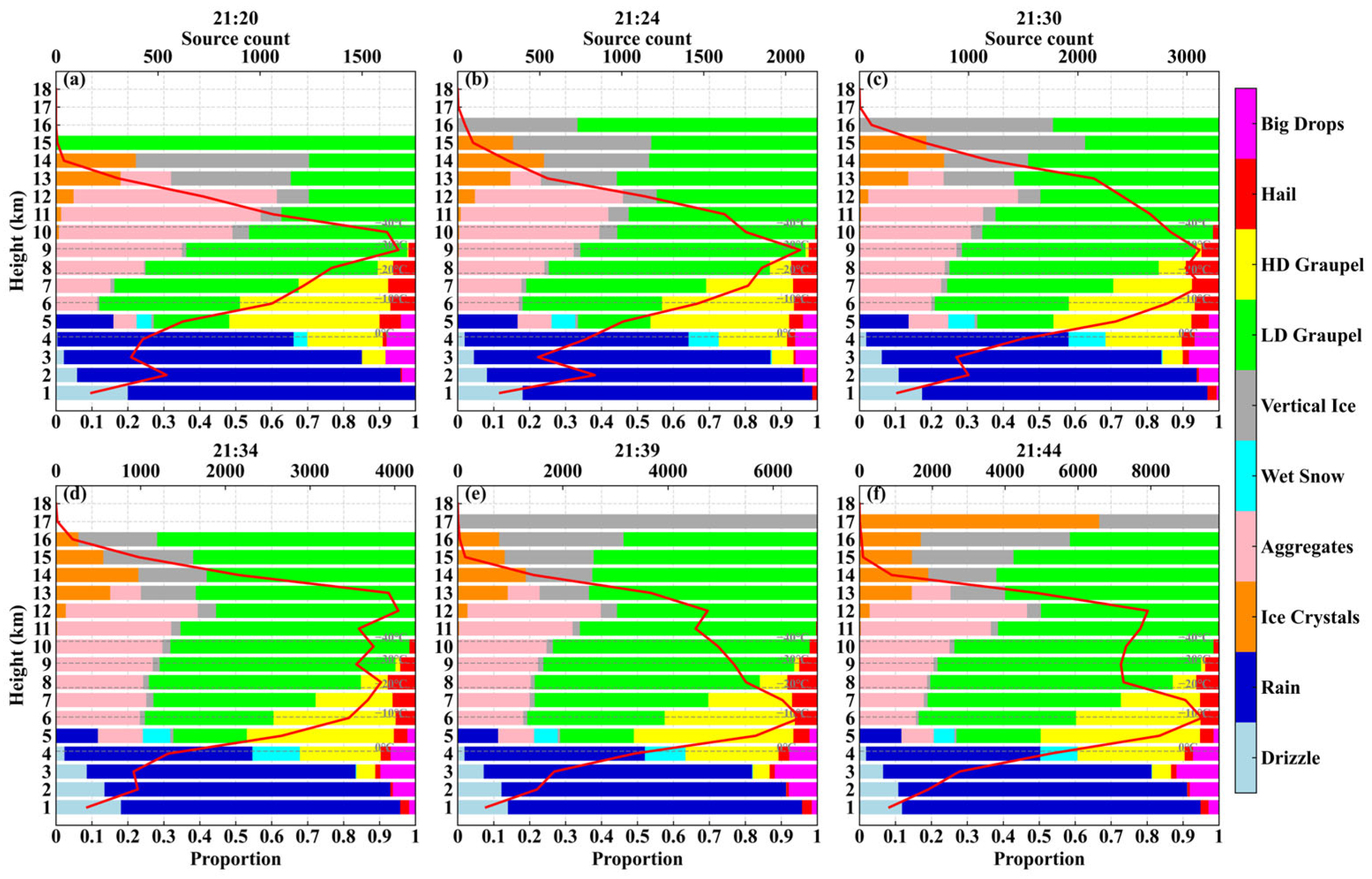
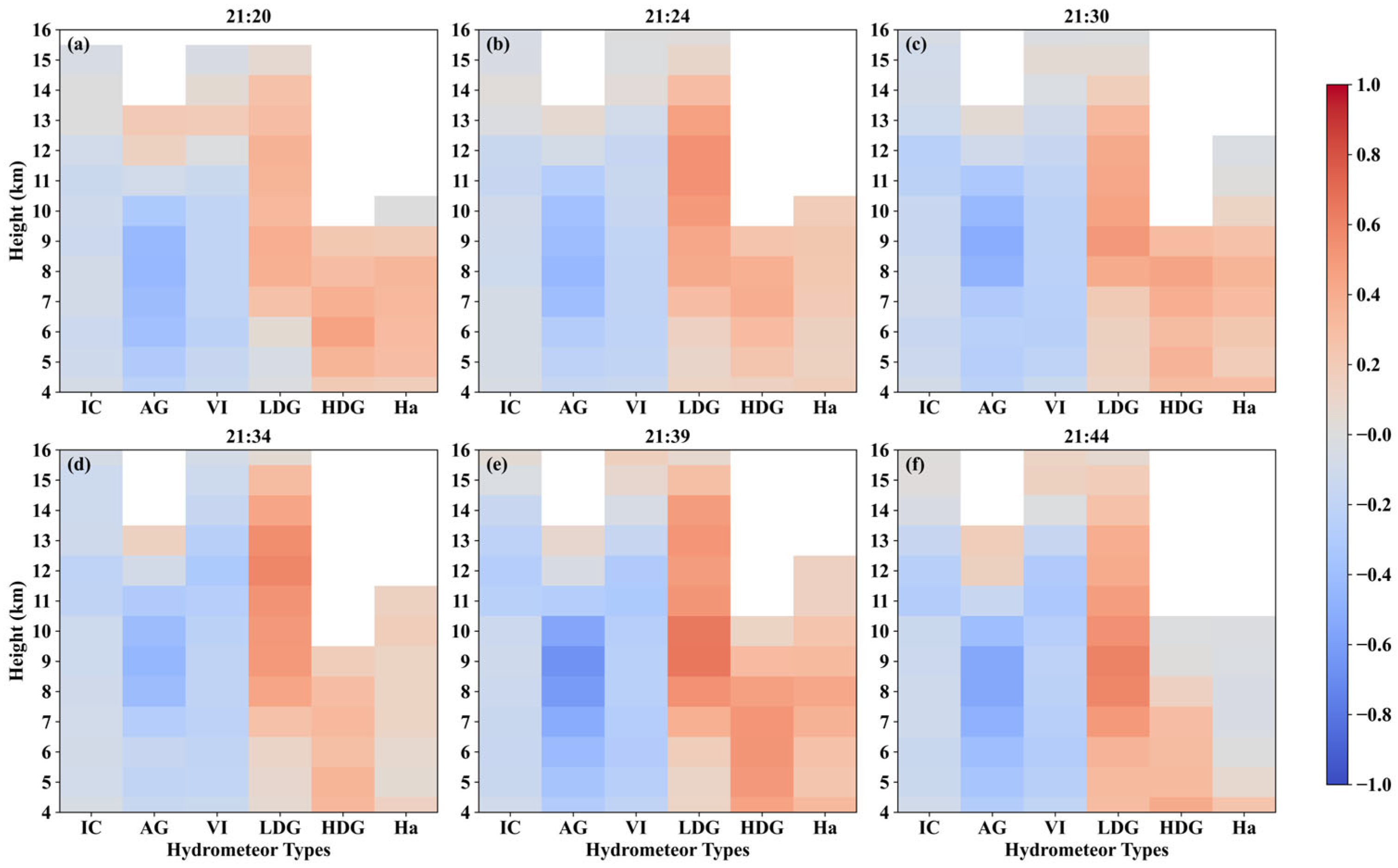
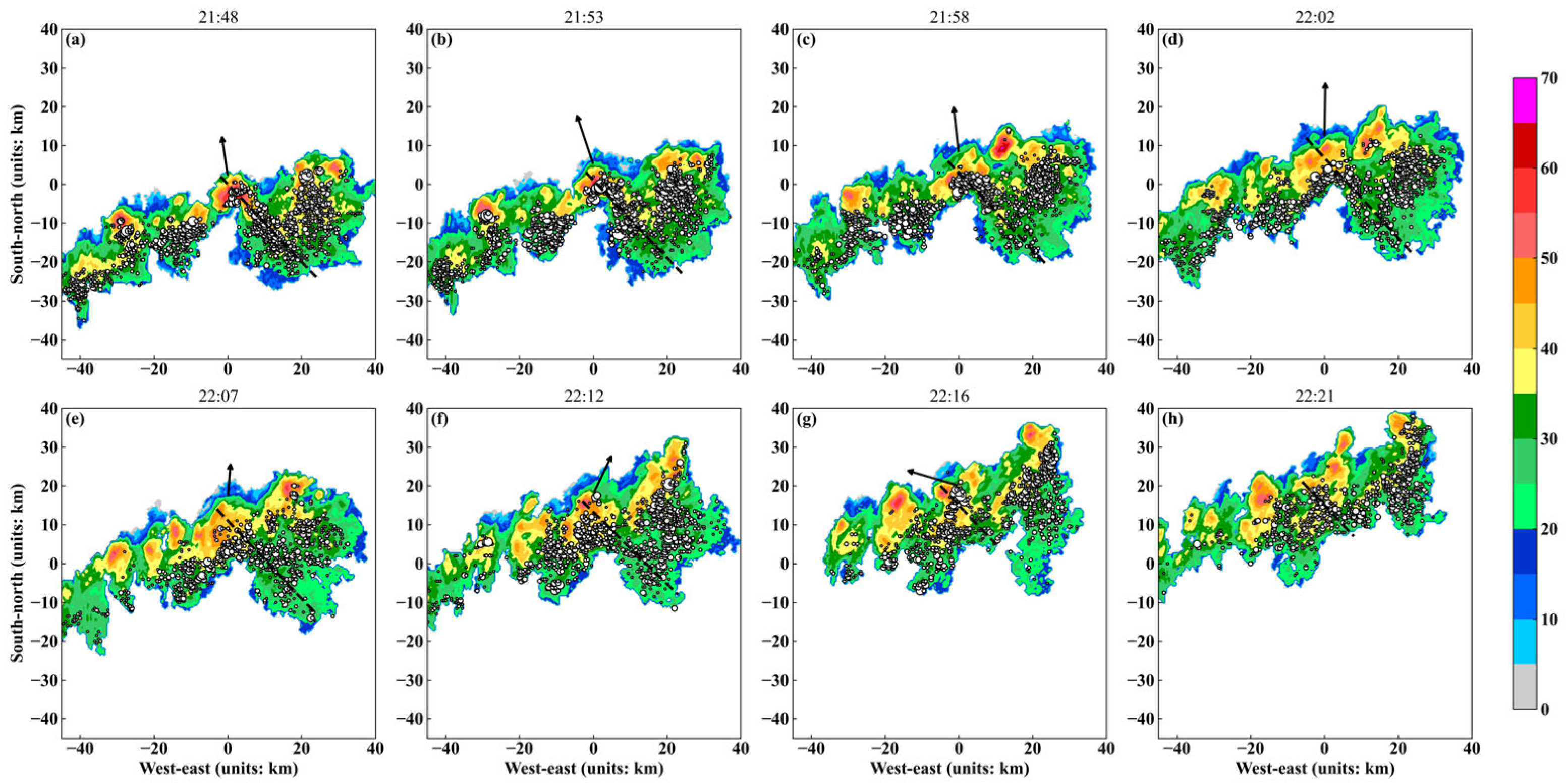
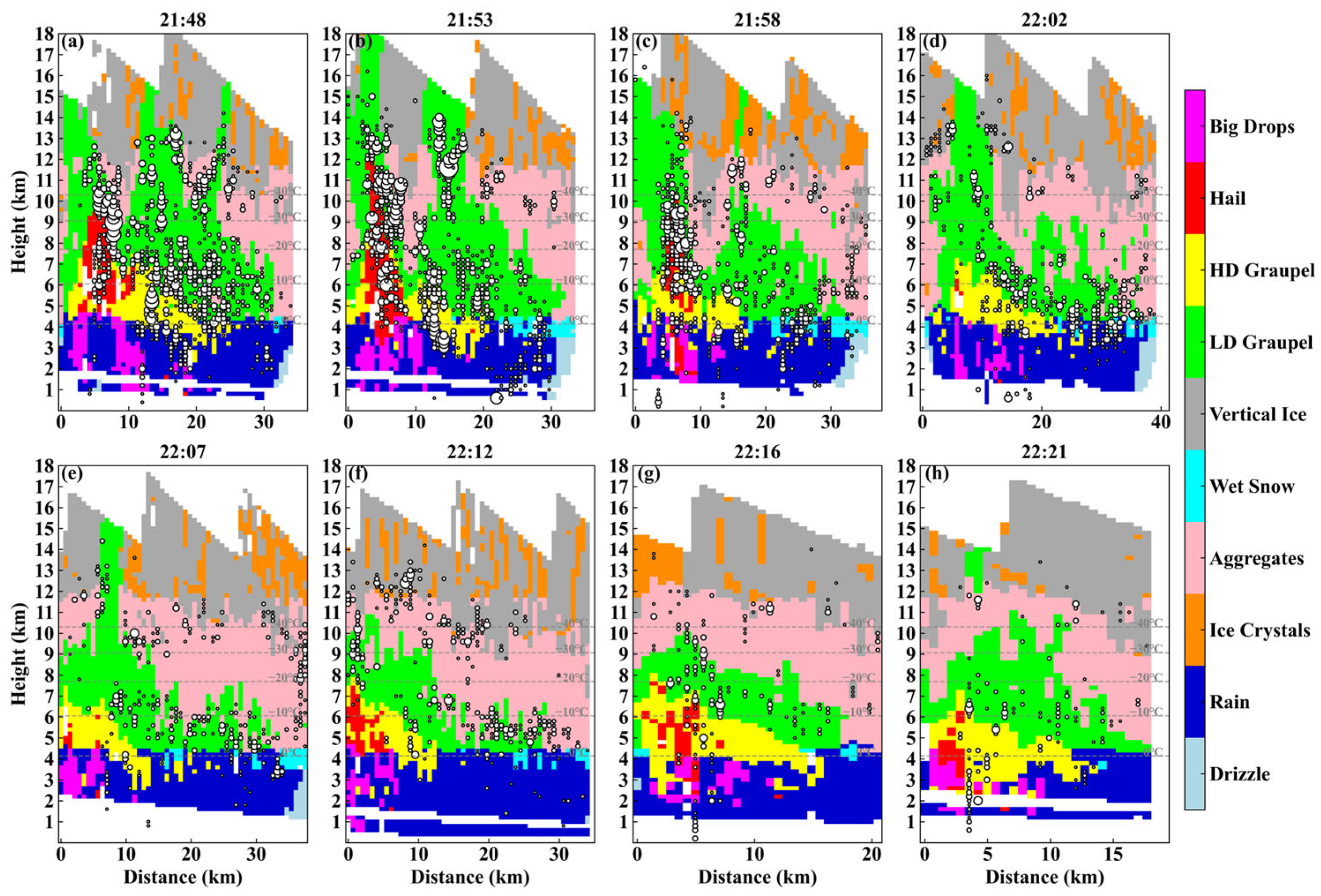
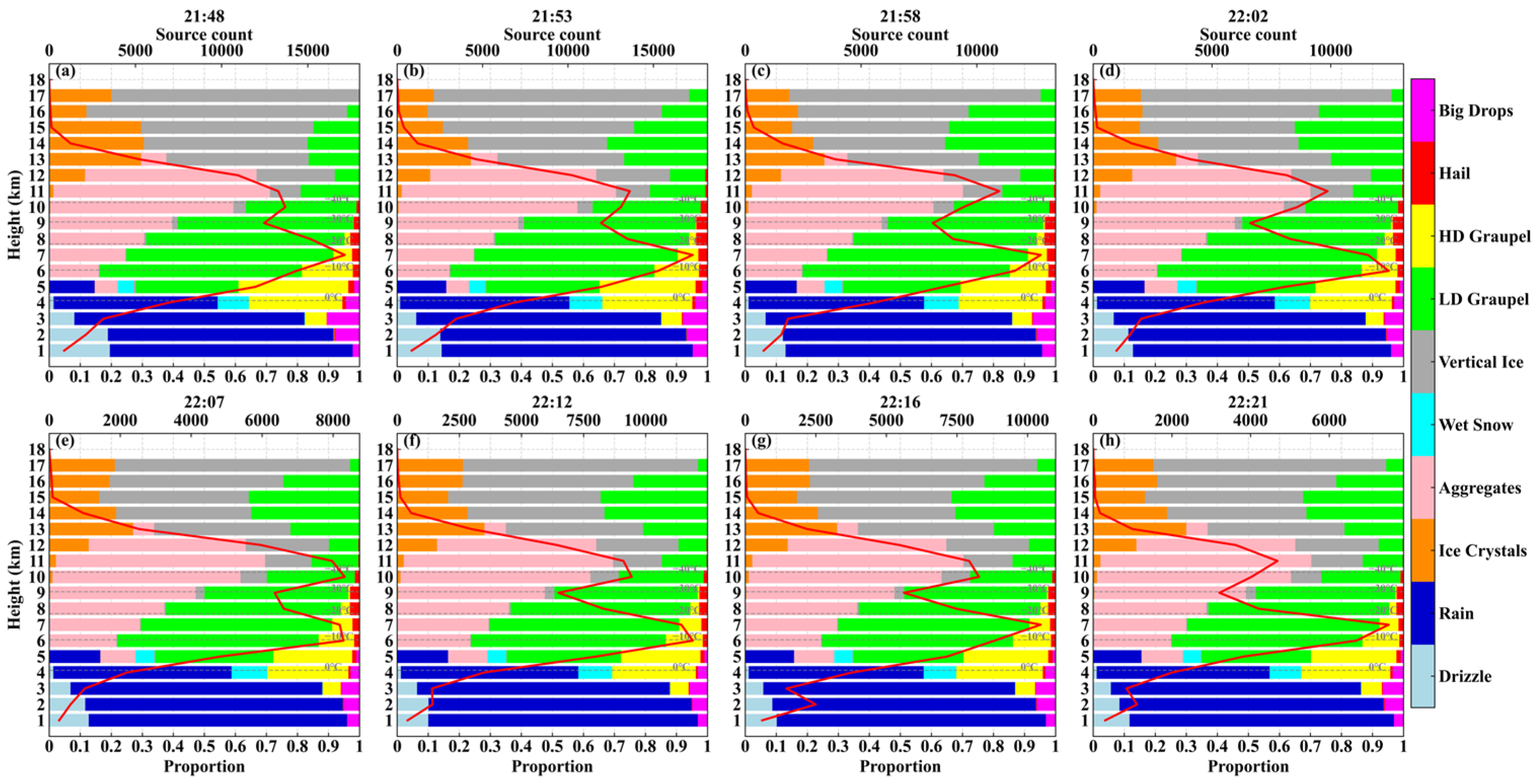
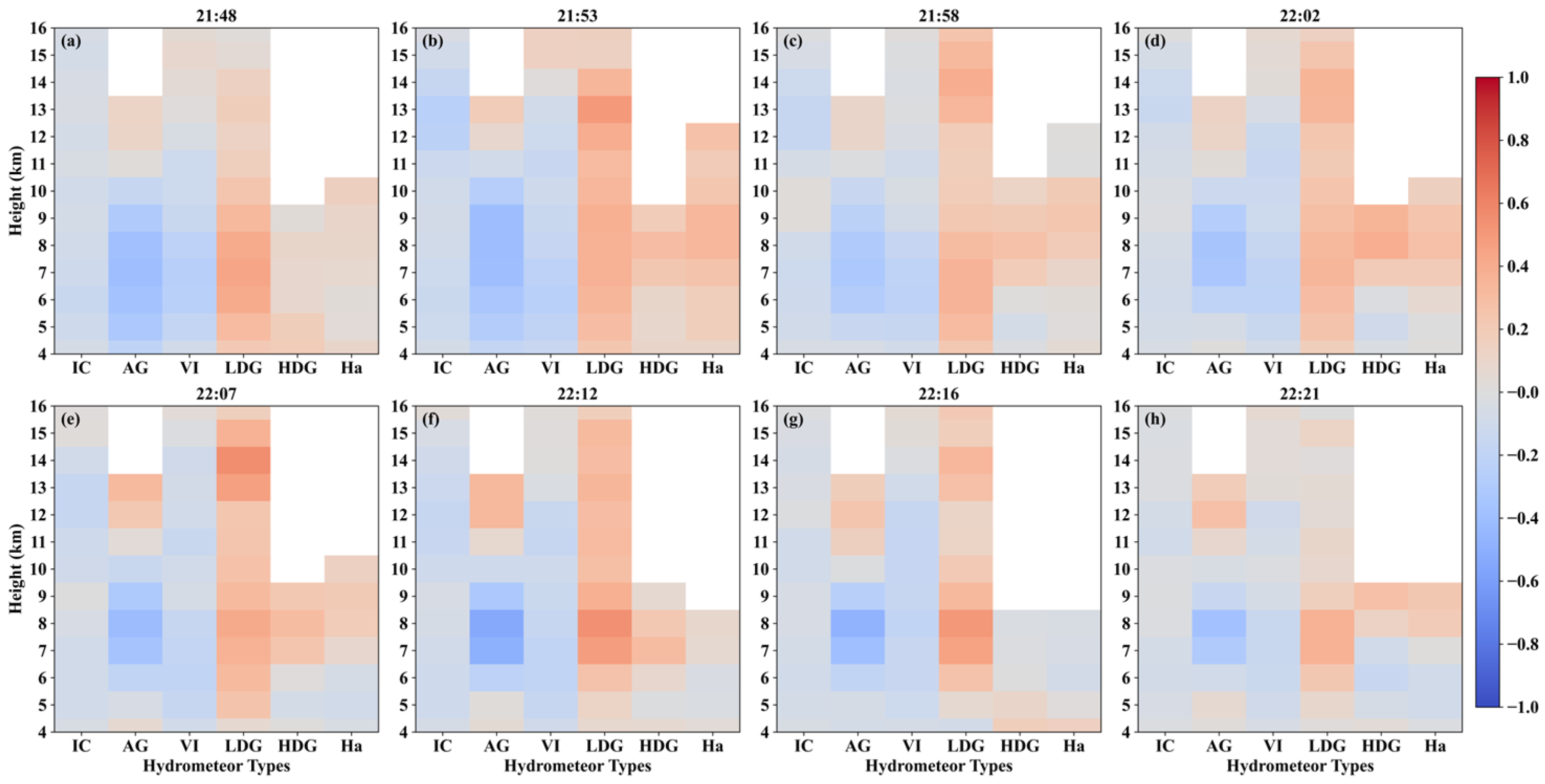
Disclaimer/Publisher’s Note: The statements, opinions and data contained in all publications are solely those of the individual author(s) and contributor(s) and not of MDPI and/or the editor(s). MDPI and/or the editor(s) disclaim responsibility for any injury to people or property resulting from any ideas, methods, instructions or products referred to in the content. |
© 2025 by the authors. Licensee MDPI, Basel, Switzerland. This article is an open access article distributed under the terms and conditions of the Creative Commons Attribution (CC BY) license (https://creativecommons.org/licenses/by/4.0/).
Share and Cite
Jiang, S.; Lyu, F.; Cummer, S.A.; Zheng, T.; Wang, M.; Liu, Y.; Lyu, W. A Case Study on the Vertical Distribution and Correlation Between Low-Frequency Lightning Sources and Hydrometeors During a Thunderstorm. Remote Sens. 2025, 17, 2676. https://doi.org/10.3390/rs17152676
Jiang S, Lyu F, Cummer SA, Zheng T, Wang M, Liu Y, Lyu W. A Case Study on the Vertical Distribution and Correlation Between Low-Frequency Lightning Sources and Hydrometeors During a Thunderstorm. Remote Sensing. 2025; 17(15):2676. https://doi.org/10.3390/rs17152676
Chicago/Turabian StyleJiang, Sulin, Fanchao Lyu, Steven A. Cummer, Tianxue Zheng, Mingjun Wang, Yan Liu, and Weitao Lyu. 2025. "A Case Study on the Vertical Distribution and Correlation Between Low-Frequency Lightning Sources and Hydrometeors During a Thunderstorm" Remote Sensing 17, no. 15: 2676. https://doi.org/10.3390/rs17152676
APA StyleJiang, S., Lyu, F., Cummer, S. A., Zheng, T., Wang, M., Liu, Y., & Lyu, W. (2025). A Case Study on the Vertical Distribution and Correlation Between Low-Frequency Lightning Sources and Hydrometeors During a Thunderstorm. Remote Sensing, 17(15), 2676. https://doi.org/10.3390/rs17152676





